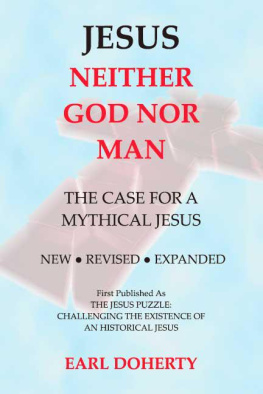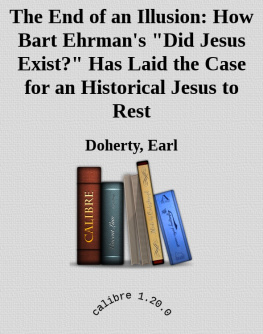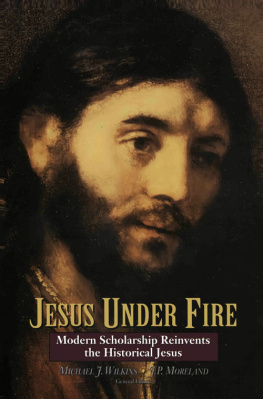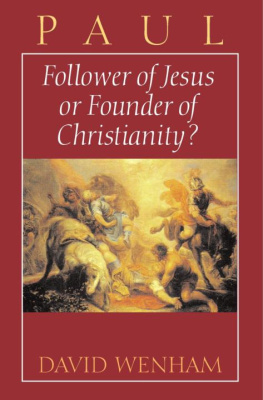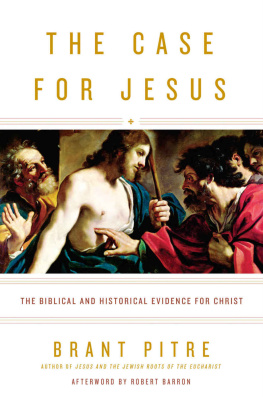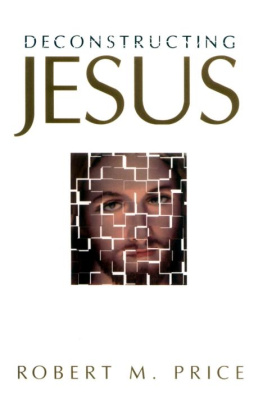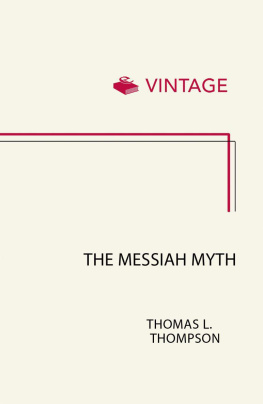Copyright 2009 by Earl Doherty. All rights reserved. No part of this publication may be reproduced, in any form or by any means, except for review purposes or in a fair use context, without the prior written permission of the author or publisher.
Jesus / Earl Doherty. New ed., rev. and expanded
Originally publ. under title: The Jesus puzzle.
1. Jesus ChristHistoricity. I. Title.
CONTENTS
________________________________________________________
Preface
About Translations / Glossary and Abbreviations
THE TWELVE PIECES OF THE JESUS PUZZLE
INTRODUCTION
I : THE JERUSALEM TRADITION
PART ONE: Preaching a Divine Son
: A Heavenly Christ
: A Conspiracy of Silence
: A Thirst for the Irrational
: Apostles and Ministries
: Apocalyptic Expectations
PART TWO: A Life in Eclipse
: From Bethlehem to Jerusalem
: The Passion Story
PART THREE: The Gospel of the Son
: The Word of God in the Holy Book
: The Intermediary Son
PART FOUR: A World of Myth and Savior Gods
: Who Crucified Jesus?
: The Mystery Cults
: Conceiving the World of Myth
: Dancing with Katie Sarka under the Moon
: Paul and the Heavenly Man
PART FIVE: Views through the Window in Scripture
: Born of Woman?
: A Sacrifice in Heaven
: The When of Christs Sacrifice
PART SIX: A Riotous Diversity
: The Birth of a Movement
: The Johannine Community
: The Gnostic Phenomenon
: Ignatius on the Threshold
II : THE GALILEAN TRADITION
PART SEVEN: Preaching the Kingdom of God
: The Nature and Existence of Q
: Excavating the Roots of Q
: The Gospel of Thomas and Q
PART EIGHT: An Emerging Founder
: Introducing Jesus to Q
: Sectarian Developments in Q
: Mark and Q: The Origin of the Gospels
III : A COMPOSITE CHRISTIANITY
PART NINE: The Evolution of Jesus of Nazareth
: The Gospels as Midrash and Symbolism
: A Tale from Scripture
PART TEN: The Second Century
: The Remaking of Christian History
: Jesus in the Christian Apologists
IV : THE EXTERNAL EVIDENCE
PART ELEVEN: The Non-Christian Witness to Jesus
: Jesus Among Pagan and Jew
: Flavius Josephus
: A Roman Trio: Tacitus, Suetonius, Pliny
: A Minor Trio: Thallus, Phlegon, Mara
APPENDICES
: Two Interpolations in the New Testament Epistles
: A Conversation between Paul and some New Converts
: Jesus and the Savior Gods: The Question of Parallels
: Dating Hebrews and the Authenticity of the Postscript
: The Gospel Chicken or the Epistolary Egg?
: The Gospels in the Valentinian Gospel of Truth
: The Redeemer in the Gnostic Paraphrase of Shem
: The Absence of an Historical Jesus in the Didache
: The Date of Minucius Felix
: Minucius Felixs Rejection of the Crucified Man
: The Curious Case of the Apology of Aristides
: Trypho and the Denial of an Historical Jesus
: John the Baptist in Josephus: An Interpolation?
: Robert Eisler and the Portrait of Jesus
NOTES
BIBLIOGRAPHY
PREFACE
________________________________________________
During the 2007 season of the television series Bones, its brainy heroine, a forensic anthropologist cum homicide detective Dr. Temperance Brennan, made a reference to the founder of Christianity with this passing comment: Christ, if he existed A similar remark was heard later in the episode, both spoken tangentially during discussions among the characters, forensic scientists at the Smithsonian Institute trying to solve the latest foul-play case of unearthed bones. This was on a major U.S. network in prime time. How many viewers caught it, or what their reaction was, is not recorded. But it may well have been the first time any of those viewers had heard such a radical idea floated in popular entertainment beamed into North American homes following the supper hour.
When The Jesus Puzzle was published in 1999, the theory that no historical Jesus ever lived was still generally regarded as a fringe idea. Although a small minority of scholars had championed such a conclusion for almost two centuries, it had achieved little traction among the public or in New Testament scholarship. Now a decade later, the idea is beginning to poke a tentative head out of parts of the mainstream scholarly landscape. Yet this has already been overtaken by a growing segment of the general public, especially among those plugged into the Internet, where presentation and debate on websites and discussion boards has increasingly intrigued and even won over many to the idea.
The advent of the Internet has introduced an unprecedented lay element of scholarship to the field. The vastly accelerated dissemination and exchange of ideas, the easy availability of ancient texts and works of modern scholarship only a click away, the absence of peer pressure and constraints of academic tenure, has meant that the study of Christian origins is undergoing a quantum leap in the hands of a much wider constituency than traditional academia. While the latter has always been centered in university Religion departments, the field is now open to dedicated amateurs, the latter being a technical term for those who undertake private study outside an official educational setting.
Mainstream critical scholarships ongoing quest for the historical Jesus is yet to arrive at any secure or consensus result. Agreement on what Jesus said and did, on whether he was a Jewish wisdom teacher, an apocalyptic prophet, a revolutionary, a Cynic-style sage, or any of a number of other characterizations, is as far from being achieved as at any previous stage of the perennial attempt to separate the glorified Jesus of faith from the elusive Jesus of history. It remains to be seen how soon traditional academia will overcome its reluctance to take the plunge into the New Testaments final, uncharted territory. It has become known on the Internet as Jesus mythicismthe theory that no historical Jesus worthy of the name existed, that Christianity began with a belief in a spiritual, mythical figure, that the Gospels are essentially allegory and fiction, and that no single identifiable person lay at the root of the Galilean preaching tradition.
There is one rebuke regularly leveled at the proponents of Jesus mythicism. This is the claima myth in itselfthat mainstream scholarship (both the New Testament exegete and the general historian) has long since discredited the theory that Jesus never existed, and continues to do so. It is not more widely supported, they maintain, because the evidence to the contrary is overwhelming, and this evidence has been presented time and time again. It is surprising how much currency this fantasy enjoys, considering that there is so little basis for it. I recommend my three-part website article Alleged Scholarly Refutations of Jesus Mythicism, a rebuttal to a century of worksrather few in number, in books and parts of booksseeking to refute the case for mythicism. It begins at: http://www.jesuspuzzle.humanists.net/CritiquesRefut1.htm .
In the early twentieth century there were a number of efforts to counter the strong current of Jesus mythicism at that time, but the works on both sides of that debate are long outdated. There has been in recent times no major published work from mainstream scholarship dedicated to disproving the mythical Jesus theory. This alone is critical, since significant advances have been made in New Testament research over the last quarter century, such as the new perception of the high midrash content of the Gospels, advances in Gnostic studies based on the Nag Hammadi documents, new insights into the Q documents layering and evolution, and so on. The case for Jesus mythicism has kept pace with these developments and has strengthened itself accordingly, yet virtually none of this has been answered by todays historical Jesus defenders. When modern scholars have commented on Jesus mythicism (as a part of books or articles devoted to other aspects of New Testament study), it has generally been a superficial affair, repeating old objections that have long been dealt with by mythicisms advocates and betraying an inadequate understanding of the depth and character of their case. It has been amateur Internet apologists, usually faith-driven, who have stepped into this vacuum and offered web-based articles attempting to refute the mythical Jesus position. These have attracted rebuttals by mythicists, including several by myself.

